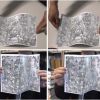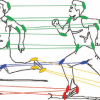139
Voted
CVPR
2009
IEEE
16 years 8 months ago
2009
IEEE
Cross-domain learning methods have shown promising
results by leveraging labeled patterns from auxiliary domains
to learn a robust classifier for target domain, which
has a limi...
117
click to vote
CVPR
2009
IEEE
16 years 8 months ago
2009
IEEE
Higher order energy functions have the ability to encode
high level structural dependencies between pixels, which
have been shown to be extremely powerful for image labeling
pro...
127
click to vote
CVPR
2009
IEEE
16 years 8 months ago
2009
IEEE
Most state-of-the-art nonrigid shape recovery methods
usually use explicit deformable mesh models to regularize
surface deformation and constrain the search space. These
triangu...
130
click to vote
CVPR
2009
IEEE
16 years 8 months ago
2009
IEEE
In this paper, we focus on the problem of detecting/
matching a query object in a given image. We propose a
new algorithm, shape band, which models an object within
a bandwidth ...
144
click to vote
CVPR
2009
IEEE
2009
IEEE
Layered Graph Matching by Composite Cluster Sampling with Collaborative and Competitive Interactions
16 years 8 months ago
This paper studies a framework for matching an unknown
number of corresponding structures in two images
(shapes), motivated by detecting objects in cluttered background
and lear...
111
click to vote
CVPR
2009
IEEE
16 years 8 months ago
2009
IEEE
We present an algorithm for clustering sets of detected
interest points into groups that correspond to visually dis-
tinct structure. Through the use of a suitable colour and tex...
112
click to vote
CVPR
2009
IEEE
16 years 8 months ago
2009
IEEE
Interactive image segmentation traditionally involves the
use of algorithms such as Graph Cuts or Random Walker.
Common concerns with using Graph Cuts are metrication
artifacts ...
129
click to vote
CVPR
2009
IEEE
16 years 8 months ago
2009
IEEE
To recognize three-dimensional objects it is important to
model how their appearances can change due to changes
in viewpoint. A key aspect of this involves understanding
which o...
144
click to vote
CVPR
2009
IEEE
16 years 8 months ago
2009
IEEE
We propose a novel probabilistic framework for learning
visual models of 3D object categories by combining appearance
information and geometric constraints. Objects are
represen...
126
click to vote
CVPR
2009
IEEE
16 years 8 months ago
2009
IEEE
This paper proposes a novel descriptor, granularitytunable
gradients partition (GGP), for human detection.
The concept granularity is used to define the spatial and angular
unce...


